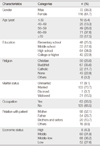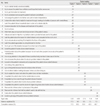Abstract
Purpose
The purpose of this study was to develop and evaluate a coping scale for families of patients with schizophrenia(CSFPS).
Methods
Item construction was derived from literature reviews and interviews with family members and psychiatric nurses. Content validity was tested by experts. Each item was scored on a four-point Likert scale. The preliminary questionnaire was administered to 188 family members of patients with schizophrenia. The data were analyzed using item analysis, factor analysis, Pearson correlation coefficients, and Cronbach's alpha.
Results
From the factor analysis, 32 items in five factors were derived. The factors were named active coping strategies, avoidance coping strategies, hospital treatment-oriented coping strategies, emotional coping strategies, and suppressive coping strategies for problematic behaviors. The five factors explained 49.7% of the total variance, Cronbach's alpha of the total items was .83 and the factors ranged from .66 to .86.
Figures and Tables
References
1. Bae SI, Rim HD, Kim YW. Stress perception and coping strategy of the families of psychiatric patients. J Korean Neuropsychiatr Assoc. 1990. 29:885–895.
2. Boye B, Bentsen H, Ulstein I, Notland TH, Lersbryggen A, Lingjærde O, et al. Relatives' distress and patient's symptoms and behaviours: A prospective study of patients with schizophrenia and their relatives. Acta Psychiatr Scand. 2001. 104:42–50. http://dx.doi.org/10.1034/j.1600-0447.2001.00190.x.
3. Choi HK. The coping style and its impact on subjective burden of families caring for the mentally ill. Korean J Soc Welf Stud. 2002. 19:203–225.
4. Chon KK, Kim KH, Cho SW, Rho MR, Shon CR. Development of multidimensional coping scale. Korean J Clin Psychol. 1994. 13:114–135.
5. Folkman S, Lazarus RS. If it change it must be a process: Study of emotion and coping during three stages of a college examination. J Pers Soc Psychol. 1985. 48:150–170. http://dx.doi.org/10.1037//0022-3514.48.1.150.
6. Hatcher L. A step-by-step approach to using the SAS(R) system for factor analysis and structural equation modeling. 1994. Cary, NC: SAS.
7. Huang XY, Sun FK, Yen WJ, Fu CM. The coping experiences of carers who live with someone who has schizophrenia. J Clin Nurs. 2008. 17:817–826. http://dx.doi.org/10.1111/j.1365-2702.2007.02130.x.
8. Jalowiec A, Powers MJ. Stress and coping in hypertensive and emergency room patients. Nurs Res. 1981. 30:10–15.
9. Kang HS, Chang SB. Development of college student's condom attitude scale. J Korean Acad Nurs. 2004. 34:751–759.
10. Kartalova-O'Doherty Y, Doherty DT. Coping strategies and styles of family carers of persons with enduring mental illness: A mixed methods analysis. Scand J Caring Sci. 2008. 22:19–28. http://dx.doi.org/10.1111/j.1471-6712.2007.00583.x.
11. Kim JH. Relations of perceived stress, cognitive set, and coping behaviors to depression. 1987. Seoul: Seoul National University;Unpublished doctoral dissertation.
12. Kim SYJ, Kim SA, Hyun MS. A new understanding and approach to family with mental illness patients. 1999. Seoul: Hyunmoonsa.
13. Kim JH, Lee JH. The relations between factors constructing stress coping style and depression. J Behav Sci. 1985. 7:127–138.
14. Korean Neuropsychiatric Association. Textbook of neuropsychiatry. 2005. Seoul: Joongang.
15. Lazarus RS, Folkman S. Stress, appraisal, and coping. 1984. New York, NY: Springer Publishing Company, Inc.
16. Lee EH. A study on the coping response of the family members of schizophrenia. Soc Welf Res Rev. 2000. 10:71–80.
17. Lee EO, Lim NY, Park HA, Lee IS, Kim JI, Bae JY, et al. Nursing research and statistical analysis. 2009. Seoul: Soomoonsa.
18. Lee GZ, Kim CK. The effect of mental health education using the videotape on the coping styles of the family members of schizophrenia. J Korean Acad Psychiatr Ment Health Nurs. 2000. 9:391–407.
19. Lynn MR. Determination and quantification of content validity. Nurs Res. 1986. 35:382–385.
20. Magliano L, Fiorillo A, Rosa CD, Malangone C, Maj M. The National Mental Health Project Working Group. Family burden in long-term diseases: A comparative study in schizophrenia vs. physical disorders. Soc Sci Med. 2005. 61:313–322. http://dx.doi.org/10.1016/j.socscimed.2004.11.064.
21. McCubbin HI, Olson DH, Larsen AS. McCubbin H, Thompson A, editors. F-COPES: Family crisis oriented personal scales. Family assessment inventories for research and practice. 1987. Madison, WI: University of Wisconsin-Maision;194–207.
22. Munro BH.
EH Lee
YH Chung
JS Kim
RY Song
KY Hwang
. Statistical methods for health care research. 2006. New York: Lippincott Williams & Wilkins;(Original work published 2004).
23. Nunnally JC, Bernstein IH. Psychometric theory. 1994. 3nd ed. New York, NY: McGraw-Hill.
24. Park HS. A study on the degree of stress and coping for the family of psychopathic patient. 1993. Gwangju: Chonnam National University;Unpublished master's thesis.
25. Schene AH. Objective and subjective dimensions of family burden: Towards an integrative framework for research. Soc Psychiatry Psychiatr Epidemiol. 1990. 25:289–297.
26. Seo JM. An inquiry into coping behavior of mothers with schizophrenic child. 1998. Busan: Pusan National University;Unpublished doctoral dissertation.
27. Stuart GW. Principles and practice of psychiatric nursing. 2009. St. Louis, MO: Mosby.
28. Tabachnick BG, Fidell LS. Using multivariate statistics. 2001. 4th ed. Needham Heights, MA: Allyn & Bacon.
29. Um MS. The family environment where one member of the family is receiving psychiatric care: A comparative group study. J Korean Acad Psychiatr Ment Health Nurs. 1992. 1:17–38.
30. Yang OK. Families of the mentally ill-care burden, coping, and service needs. J Korean Neuropsychiatr Assoc. 1995. 34:809–829.




 PDF
PDF ePub
ePub Citation
Citation Print
Print







 XML Download
XML Download